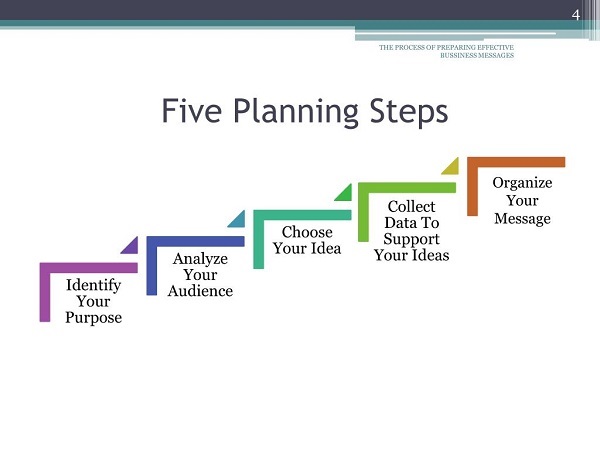Planning a Business Message
This article discusses the importance of Five steps For Preparing and planning a business message.
The success of a business depends upon the way one communicates one’s message to others. The writer of a business message, therefore, needs to plan, organize, draft, revise, edit, and proofread his message. If a message is not properly planned and worded, it may not only tarnish the image of the writer but also adversely affect the image of the organization he/she represents. Thus excellent business results can be achieved only by sending effective messages.

Therefore, to prepare effective messages, the writer should consider the following:
. Five Planning Steps for effective Business Messages . Choice of Basic Organizational Plan . Beginning and Ending of Messages . Composing of the Message
Five Steps for Planning a Business Message
To communicate effectively, consider the following five steps for planning a business message:
1. Identify your Purpose 2. Analyze your audience 3. Choose your ideas 4. Collect data to support your ideas 5. Organize your message
Identify your Purpose
The first of the five planning steps of a message is to have a clear idea of its purpose. Normally, the purpose of the message is two-fold: the reason for the message itself and the creation of goodwill. The first step when planning a message is to determine its specific purpose. Your message may be informational, such as announcing your firm’s new address. It may be persuasive, such as asking the customer to buy a particular product. Besides, all messages have an underlying purpose to create goodwill. Courtesy and consideration are especially necessary to create goodwill. Consequently, if the purpose is not clear in the mind of the sender, the communication will fail to achieve the desired feedback.
Analyze your audience
Seeing the message from the receivers’ point of view, and keeping in mind, the needs, interests, attitudes, and culture, help to analyze the audience. You can imagine the audience or reader if you know them. Much of your writing, however, will go to people or companies you have never met. So be careful with the salutation of the message. Pay attention to the proper placement of first and last names and correct titles.
Choose your ideas
Afterward, you have to choose the ideas for your message which is the second step for planning a business message. Thus, if you are answering a letter, underline the main points to discuss, and jot down your ideas in the margin. Likewise, if you are writing an uninvited or a complex message, begin by listing ideas as they come to you, and then choosing the best ideas for your receiver.
However, the ideas you include depend on the type of message you are sending, and the background and location of your receiver (national or international). For example, in a reply from a large resort hotel to a person who has asked about rates, you might send a brief list of in- and out-of-season prices. But if you will limit your response to this list, you would miss an opportunity to sell the other services you have to offer. Include the following ideas in such kind of response:
A. First, thank the reader for the letter, asking about rates. B. Then, mention the services the hotel provides. C. Similarly, Include information about the place where the hotel is located. D. Then, Give details about the facilities you offer. E. Finally, list the rates.
You might also include a brochure of your hotel along with small brochures of famous sights in your area.
Collect data to support your ideas
After this, you must determine whether you need specific facts, figures, or other forms of evidence to support your points. Moreover, be sure you know your company policies, procedures, and product details if your message requires them. Also, check your data on the names of individuals, dates, addresses, etc. Similarly, you may sometimes need to enclose a brochure, table, picture, or product sample. Lastly, be sure to collect enough data to support your ideas.

Organize your message
This is the last of the five steps for planning a business message. Before you write your first draft, outline your message (mentally or on paper). Moreover, the order in which you present your ideas is as important as the ideas themselves. On the other hand, jumbled and pointless messages are often confusing, and unimportant. However, different tactics are necessary for different cultures. While the U.S. businesspeople often prefer the direct style, South American, middle eastern, and Asian countries like the indirect style. Additionally, Europeans most often use the direct approach. Therefore, choose your organizational plan after you have worked through your basic five planning steps for planning a business message.
The above-discussed five steps are essential for planning a business message.
You May Also Like to Read
Find Us
https://www.linkedin.com/company/ewriter29/





Helpful article. Thank You!!!
easy to understand. thanks
Very well written and helpful material , God bless you.
Really good Approach
Easy to read and understand
I like u r article .it very help full .
very helpfull